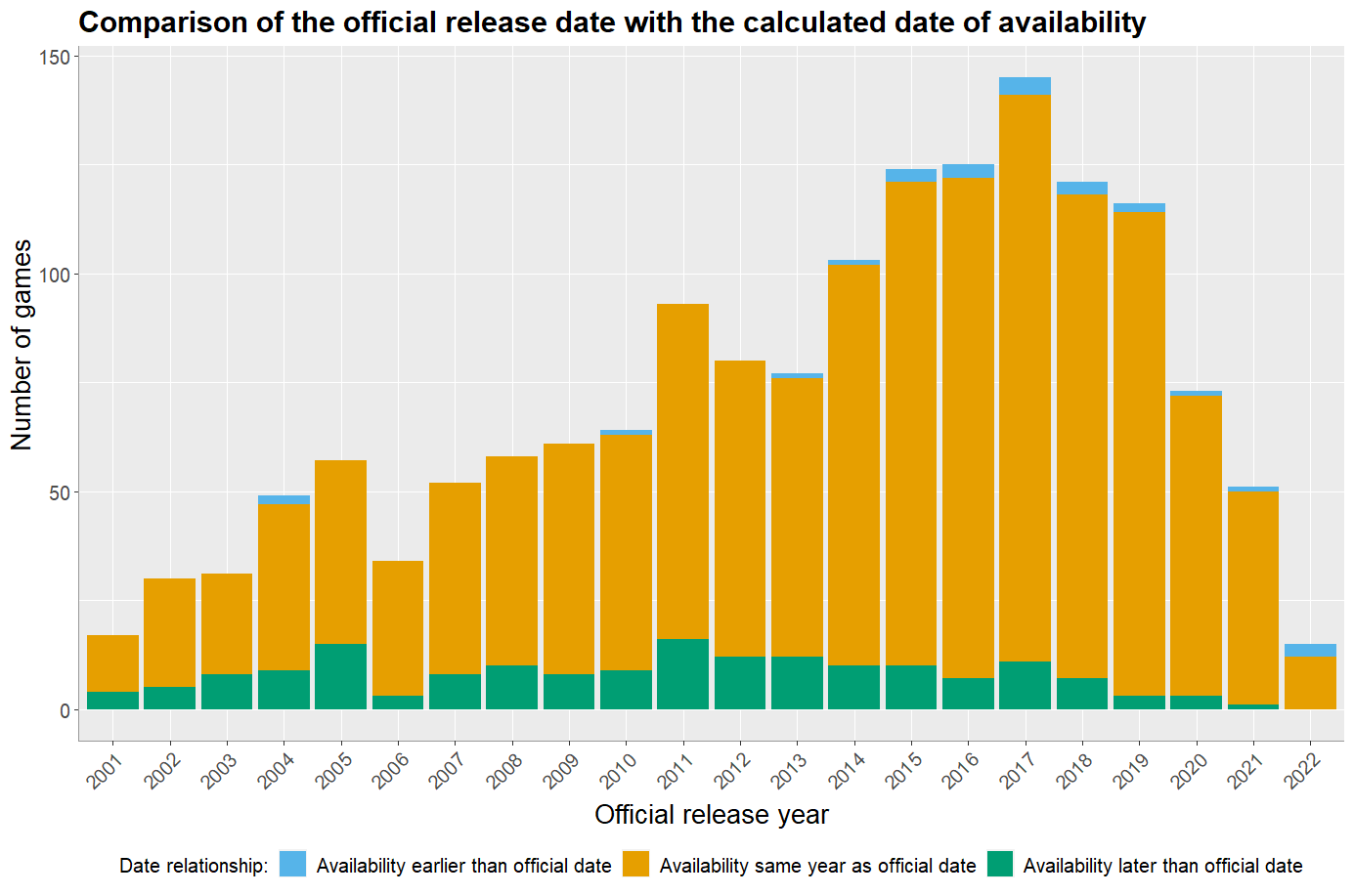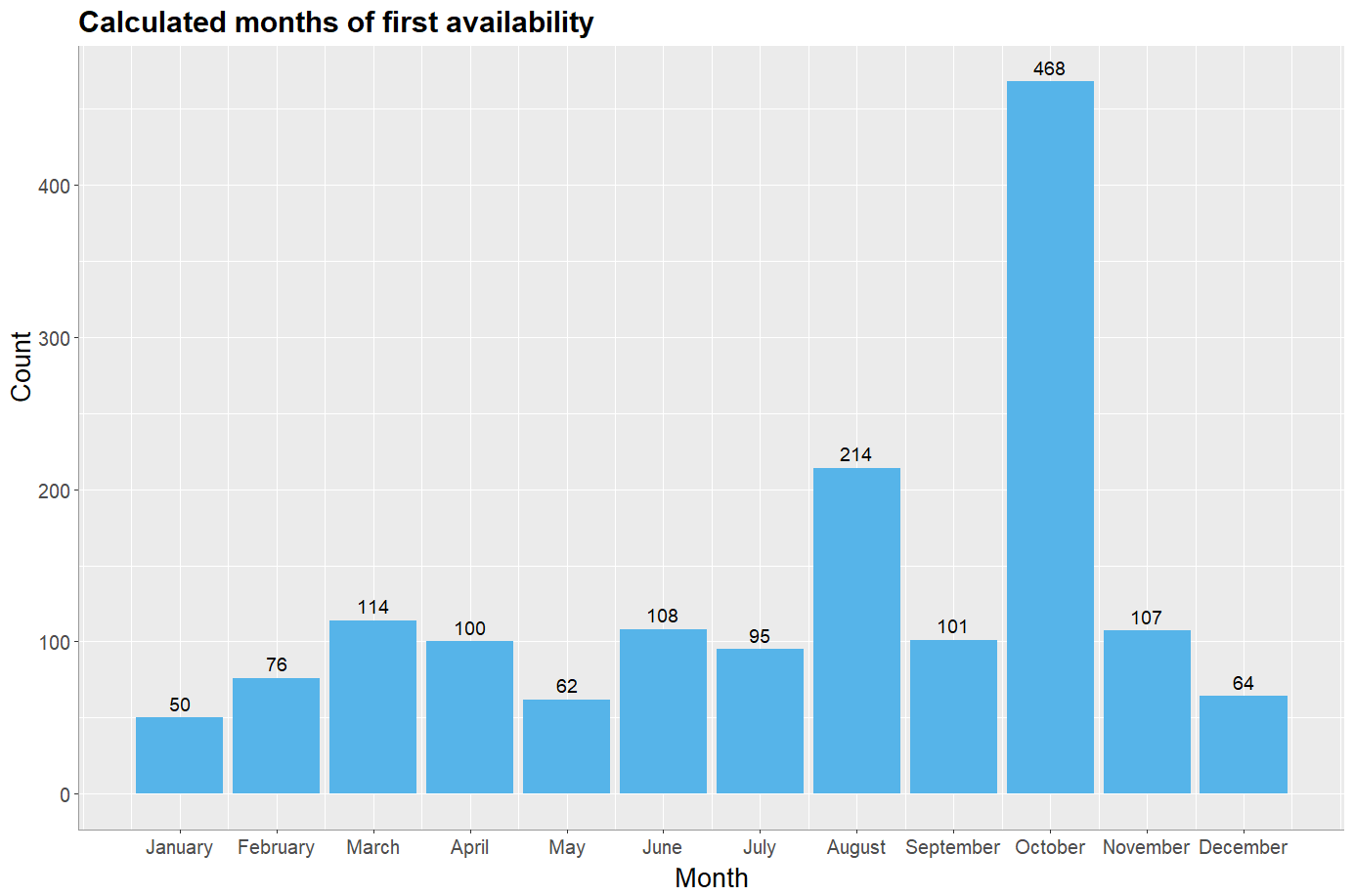Official release date in comparison to first rating and availability

For each game on BGG, the year it was officially released is given. The correlation between this date and other dates, such as the date of the first rating or the date of calculated availability, is examined in this article. Also, the first availability of games in the course of the year is analyzed.
About the dataset
The dataset used consists of reviews submitted for games on BoardGameGeek. Included are ratings that were submitted before 01/01/2023. The dataset only includes games that have received at least 2000 ratings at the specified time. This restriction is intended to prevent games with few ratings from distorting the analysis.
Release date on BGG
For each game on BGG there is a release year in which the game was officially released. For very old games like Chess, Go or Crokinole these dates are rather estimates. In the more recent past, on the other hand, these figures are very accurate.
But the meaningfulness of this year number is limited. Already years before the release, an entry can be created for a game. Thus, ratings can be given well before a game is released. Also the real availability can be different from the official release. Just because a game has been released does not mean that it is available. If only a very small group can actually play a game, but the rest of the gaming community has to wait months or even years for availability, what is the true availability date?
To analyze this question, the existing data set was analyzed. In addition to the year given by BGG, two other dates are identified. On the one hand, the month and the year of the first rating of a game. This date can precede the official release date of the game. On the other hand, the month and year when a game became available is determined. Under this information, we understand the time when a significant part of the players have access to the game.
Calculation of the date of availability
Since there is no date indicating when a game became available, an attempt is made to determine it by looking at the available data. For this purpose a formula was created, which determines the availability based on the ratings of a game. The following describes how this formula is constructed.
For a game to be considered available, it must have accumulated a certain minimum number of ratings per
month over a given continuous period of time. The number of ratings per month is the minimum value of one of
two numbers:
The first number is a set value depending on the year of publication, which correlates with the popularity
of BGG. As BGG has attracted more and more visitors over time, the value of required ratings increases over
the years.
The second number is a tenth of the maximum number of ratings given to a game in any one month. The smaller
of the two numbers is used to determine availability.
The length of months in which this number of ratings had to be submitted is a fixed value, which also
depends on the popularity of BGG. As the popularity increases, a higher number of consecutive months is
required. The values depending on the years are shown in table 1.
The first month of the series that meets this condition is set as the month of release.
Table 1
Values for availability calculation
| Official release year | Minimum ratings per month (if smaller than 10% of maximum ratings in a month) | Months in a row with minimum number of ratings |
| before 2001 | - | - |
| 2001 - 2002 | 1 | 1 |
| 2003 - 2004 | 2 | 2 |
| 2005 - 2006 | 3 | 3 |
| 2007 - 2009 | 5 | 3 |
| 2010 - 2016 | 10 | 6 |
| 2017 - 2019 | 12 | 6 |
| since 2020 | 20 | 6 |
Sample calculations for number of ratings needed per month:
Game released 2007
Maximum number of ratings in a month: 247
Availability conditions: 3 months in a row with at least 5 ratings
Game released 2012
Maximum number of ratings in a month: 42
Availability conditions: 6 months in a row with at least 4 ratings
First ratings compared to official availability
In chart 1, the official release year is compared to the year of the first rating for the games in the dataset. For a game, the first rating can appear either in a year before the official release, in the same year, or in a later year.
Chart 1

From the chart, it is apparent that most first reviews are made in the same year as the release. However, since there is no month specification for the official date, there may theoretically be a difference of up to eleven months here. Unfortunately, no more precise information can be determined for this. If the first reviewers were normal customers who bought the game, the conformity with the year of release would be the normal case.
However, the chart shows that as the years go by, an increasing proportion of games receive their first reviews in a year before the release. Whereas in the early years, virtually no reviews were given before the year of release, for games from 2021, over half of all first reviews were given in 2020 or earlier.
Several reasons may account for this trend. Due to the constant increase in influencers in the board game sector, a lot of information is communicated to customers in a decentralized manner. Distributing information as widely and early as possible allows publishers to increase visibility of games before they go on sale. Another type of early reviews is due to the rise of crowdfunding platforms. Many board games are now funded through Kickstarter. Many of these games are already being reviewed right in the period of backing, even though the game's release is still a long way off. In some cases, accumulations of 10s and 1s can be observed for these games, along with discussions before a prototype has even been seen. The founding of Kickstarter in 2009 and the subsequent rise in popularity also fits with the rising numbers from the chart.
In contrast to the early reviews, there are games that did not receive their first reviews in the year of release, but rather in a later year. From the chart, we can see that this has not happened in any of the considered games since 2017. This rather rare case can occur, for example, when a game is released but does not become available until the next year. Since nowadays many copies are distributed by publishers before release, it is also not surprising that this has not happened in recent years. Other reasons are for example the re-declaring of games on BGG. At the request of publishers, for instance, who see combined versions of a game in a single listing there as two separate games. If BGG complies with the request, a new entry is created with a date in the past, which consequently can only collect ratings from that point on.
Calculated availability compared to official availability
After the analysis of the first ratings showed that they are often given before the game is released, the calculated availability of a game should be closer to the official release date. Chart 2 shows the comparison of the official date with the calculated availability.
Chart 2

From the chart, it can be seen that the calculated availability largely matches the year of the official release. A small part of the games is not available in the year of release, but in later years. You can see that this number is lower in the most recent years than in the years before. However, here we must also take into account the data set, which only includes games with at least 2000 ratings. In order for a game from recent years to reach this limit, it must also be available. It is possible that an updated dataset in the future will show different ratios in these years.
There are even games that are available before the published date. These include Kickstarter games, for example, which have already shipped before the scheduled date. Generally, for the games that meet this condition, the availability is usually at the end of a year and the official date is at the beginning of the following year.
The calculation formula used to determine the availability date is also not error resistant. Although the formula is intended to determine a date that is as accurate as possible, individual games may have had an availability date calculated that is too early or too late.
In chart 3, the two charts 1 and 2 are once again shown in direct comparison.
Chart 3


First availability of games over the course of the year
Not only was the year of availability calculated for each game, but also the month. Looking at the months of all games that are in the dataset, we get graph 4.
Chart 4

For each month, the graph shows the number of games that were available as of that month according to the calculation. Excluded were games that were released in 2000 or earlier, since no data can be found for these games on BGG. Games that were officially released in 2001 are also excluded, since the first ratings could only be submitted from May 2001.
It is clear from the graph that most games were available to players from the month of October. With 468 out of 1559 games, about 30% of all games became available as of this month. This observation is no coincidence. Every year in October, the world's largest board game fair takes place in Essen, Germany, called "Spiel". For board game publishers, this period is often the most important in the whole year. Many important new products appear during this period. Often a year in the board game cosmos is even not separated at the end of the year, but instead goes from one "Spiel" to the next "Spiel". Due to this special position of the time in October, it is only logical that most games are also released and available at this time.
The second busiest month of the year is August. 214 out of 1559 games were available from August, which is about 13.7%. Unlike October, there is no clear reason for the higher number of games here. Possibly many of these games are precursors to "Spiel" and serve to generate interest before the fair. By making games available to influencers and first customers, initial reviews are available and potential customers can form a first impression.
Many other months are around a similar level, with about 100 games per month. At the lower end of availability are the months of January, February, May and December, which contain between 50 and 76 games. So there seems to be a "winter hole" where relatively few games reach the consumer market. After the period of major releases during the "Spiel" and after the Christmas business, this is also not unexpected.
